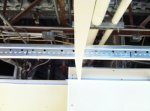Is the Cross-T-Squared the
Best Suspended Ceiling Tool?
The short answer is, yes, because the Cross-T-Squared saves you (or your installers) time and money on every single suspended ceiling job you do.
I started in the T-bar trade in Las Vegas in 1980. I have used my XT2 (my nickname for this tool) on every single project I have been on since 2004, when I invented what's become known as the "best suspended ceiling tool".
But, I don't expect you to just take my word on this.
Please, check out the Cross-T-Squared for yourself, and you'll see what all the buzz is all about too.
The Cross-T-Squared will:
- Perfectly align perimeter tees before you punch/rivet or berc clip them
- Allow you to cut-in to an angled/radius wall as fast as a straight wall
- Build soffits faster than you ever thought was possible
- Make precise field splices for patch and repair jobs
- Stop you from pulling out your tape 100 times day
- Save time, labor and materials on every single job
- Save up to 5 man hours per week per installer, on every single grid job
Standard 15/16" Grid Systems
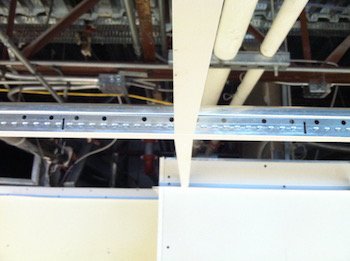 You have seen this a million times before, a perimeter tee that needs to be set before you rivet or berc clip. Instead of "eyeballing it" or reaching for your tape, like you normally do... 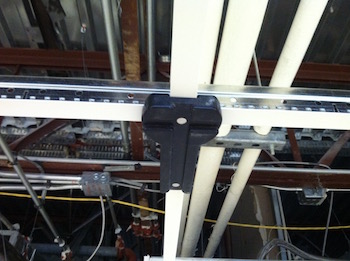 Grab the "best suspended ceiling tool", and set it up to the grid. Once the tool locks onto the main, slide the tee left or right until it locks in, too. That's it, the tee is now perfectly aligned, and ready to clamp, punch and rivet (for the "popped side"), or snap on the Berc or ACM7 clip (for the "un-popped side"). Click, click, done! |
Standard and Slotted 9/16" Grid Systems
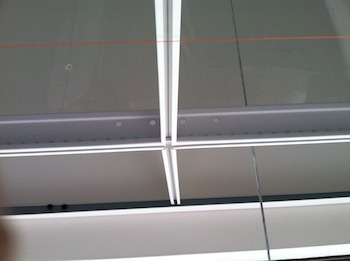
Here we have a 9/16" slotted tee, that needs to be aligned as well.
Grab your tape? Or a speed square? Maybe the "trustee eyeball" again?
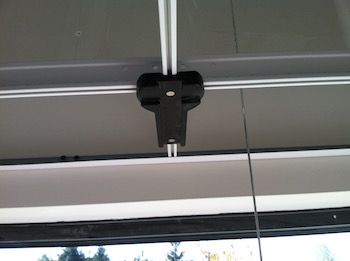
Personally, I do the same thing I have done since 2004. I grab my Cross-T-Squared, and flip it over to the 9/16" side.
Then, simply repeat the process above, slide the tool onto the main, then slide the tee left or right, until the tool locks in.
Click, click, done!
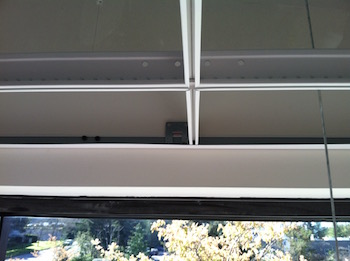
This is my "popped" side. I snap on a berc (or ACM7) clip and screw the clip to the upper wall angle leg.
Double check my cut-in line, then put another screw through the clip slot and the web of the tee.
What could be easier?
Works on Soffits, too.
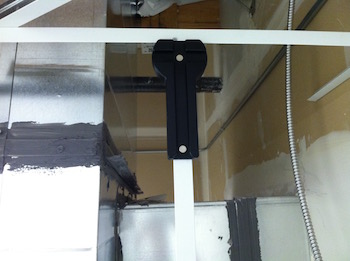
Once the tee is riveted to the upper wall angle (or lower, depending on your preference), it's time for the Cross-T-Squared again.
Simply align the outer tool edge to make complete contact with the wall angle, and the tee is now perfectly plumb. This suspended ceiling tool will work from either the top-down, or the bottom-up.
Click, slide, done!
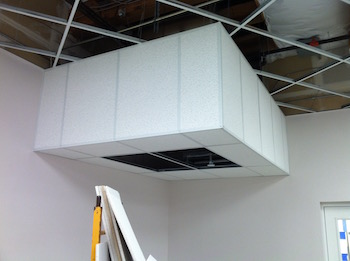
Then simply, clamp, punch and rivet the tee to the other wall angle. Repeat for each vertical tee. There is simply no faster way to build a soffit!
This soffit was built and tiled in just over an hour. 75 minutes to be exact.
Cross-T-Squared Features
- Works on all 15/16" & 9/16" face ASTM C635 & C636 approved systems
- Dual rare earth magnets work horizontally, vertically, and even on a slope
- Radius detail on every edge for ergonomics
- Compact - measures 3" x 6 1/2" and weighs just 2.5 ounces
- No moving parts to adjust or replace
- Each tool is individually cut on state-of-the-art CNC machine
- Slots are tapered cut to match ASTM C-636 and C-636 tolerances
- Manufactured with pride in the USA
- Will not damage or scratch the grid finish
- 30-day risk-free test drive and limited lifetime warranty
Save Time. Save Money. Save Materials.
T-bar installers and suspended ceiling contractors using this tool have told me that the Cross-T-Squared saves them time, money, and materials on every single job they do.
Several have stated that they hope their competitors don't find out about this tool!
Imagine how much more competitive your bid is when you're saving about $150 - $200 per installer per week installing the grid (it's no wonder they want to keep this tool a secret!).
Save Time - On a 50' wall where every tee has to be pop-riveted, theoretically you'll pull your tape measure out 24 times, once for each cross-tee. After substantial testing, I have calculated that a T-bar installer doing grid 40 hours per week without this ceiling tool costs you up to an extra five hours per week.
That's a lot of time (and money spent) just measuring and spacing perimeter cross tees before you rivet or berc clip them.
Save Money—For each installer making $50 per hour, using the Cross-T-Squared tool will allow them to recover up to an hour per day, potentially saving $150 - $200 in straight labor costs per installer per week.
Don't forget the savings on labor overhead, too. This can translate into lower bids, or higher profit margins for your company.
Save Material—Eliminating any errors in the perimeter tee spacing saves materials. Perfectly aligning vertical soffit tees the first time means no "adjustments" need to be made after the fact.
When the Cross-T-squared is used for alcoves or around wing walls, getting the right measurement for the slot cut the first time also results in saving time and material.
Take it for a test drive - I am so certain that the "Best Suspended Ceiling Tool" will save you time, money, and material every time you use it that I offer a 30-day risk-free test drive.
If you aren't happy with the tool for any reason at the end of 30 days, simply send it back and request a refund of the original purchase price.
It's that simple.
Curtis Dennis
